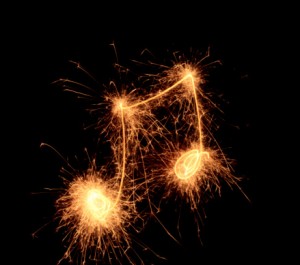Rock and Roll Redemption
By Asher Crispe: January 14, 2011: Category Inspirations, Simple Rhythms
Hey they’re playing our song!
 Part of musical culture is to identify on a deeply personal level with the music. There are songs for all occasions. Certain songs define a generation or an event while others paint us as individuals, punctuating our lives. We hear a familiar tune and we are transported across time and space, through the nexus of memory and imagination. We can find or lose ourselves in the music. Rapt in meditation, we may become strapped to the emotional pivot of a magnetic music experience. Crowds sway.
Part of musical culture is to identify on a deeply personal level with the music. There are songs for all occasions. Certain songs define a generation or an event while others paint us as individuals, punctuating our lives. We hear a familiar tune and we are transported across time and space, through the nexus of memory and imagination. We can find or lose ourselves in the music. Rapt in meditation, we may become strapped to the emotional pivot of a magnetic music experience. Crowds sway.
The mass appeal of music is indisputable. Dubbed the universal language, music breaks down many of our psychological boundaries and taps the unknowable depths of the soul. Moreover, everything that exists has a song or—perhaps more radically—is a song. The classic work of Jewish mysticism known as the Zohar, even suggests that there is an essential melody connected with the most sublime spiritual beings, minute earthly creatures or even lowly inanimate objects, who sing in some abstract sense before their Creator.
In other words, music has the capacity to turn all things towards their ultimate reality. It is a testament to the ‘Wholeness of Existence’ that manifests itself in the form of a uniquely generated musical composition. There are even some String Physicists who contend that the fabric of the universe emerges fundamentally from a cosmic symphony—the notes and tones of which resonate for us as the familiar forces and bits of matter.
For King David, the soul singer of Israel par excellence, music fuels all sorts of transcendent connections. One of King David’s lesser known compositions is a work called Perek Shira or the Chapter of Song. In this wondrous text we learn of the musical secrets of the heavens and the earth, of paradise and hell, of the deserts, fields, the seas and rivers, of days and nights, sun, moon and stars. All are singing. And it doesn’t stop there; all of the planets and animals contribute their songs as well. No two melodies are the same.
paradise and hell, of the deserts, fields, the seas and rivers, of days and nights, sun, moon and stars. All are singing. And it doesn’t stop there; all of the planets and animals contribute their songs as well. No two melodies are the same.
There is even a special group of musical performers within the social body of Israel known as the Levi’im or Levites who come from the tribe of Levi. It is the Levi’im who provided the musical accompaniment to the services of the first and second Temples in ancient Israel. Moses or Moshe, was from the tribe of Levi, and therefore was endowed with special musical abilities. According to Chassidic tradition, as the guide for the Jewish people, he possessed the secret of each person’s soul melody. His capacity to cultivate a profound connection with every person stemmed from his being attuned to each individual’s musical frequency and vibe.
Tapping into the innermost aspects of a person’s inner psycho-spiritual make up through music forges the bond between the leader and his people. By extension, the Zohar enjoins us to view Moshe as a recurrent figure throughout history. This concept becomes a central pillar in the organization of Chassidic thinking: there is a living representation or embodiment of Moshe in every generation. One can think of such a leader as a reincarnation of the original Moshe. Moshe consequently becomes the archetype of all communal leadership and the greatest asset of that leadership is the knowledge of each and everyone’s soul song.
So too, the ultimate redeemer—Moshiach—is seen in Kabbalah as a person who possesses an inner dimension of the soul of Moshe. Riding along with this idea, is the notion that Moshiach will transform the world through the power of music. Stretching back to the through ages, the rabbis have taught that the whole of history could be depicted in terms of ten songs, nine of which have already been sung. It is the final song that will sung by Moshiach as the whole world awakens to the consciousness of its true potential.
“How long to sing a new song…”
—U2
Thinking back over the most intense periods of global transformation, it would appear that each era was accompanied by a more expansive, liberalized concept of music. In the sixties with the Woodstock festival (to cite a mega-famous example), the sense of the transformative nature of music became ever more pervasive. Rock and Roll, as the trending music of rebellion, was also charged with an agenda of remaking the social and political order. As a refuge for seekers of peace and freedom, Rock and Roll became associated everywhere with widespread dissatisfaction with the way of the world and a new stirring desire for something more or something different. Songs of protest would come to encapsulate some primal scream for change.
So whether it be “We are the world” or some other ultra-recognizable song title tied to social change, the redemptive power of music is only beginning to be explored. Beyond the intention to bring people together, the currents of music can we wielded in even more extensive ways for the benefit of all humankind. Thus, a kind of ‘Rock and Roll redemption’ is in concert with the normative Jewish belief in a Messianic age when we will be begin to sing a radically new song that will ripple throughout the world as a catalyst of global transformation.
Along these lines, there is another basic teaching of the Sages, which tells of how Moshiach will reveal a new dimension from within the eternal Torah. This enigmatic dimension has to do with the musicality of the Torah text. In a liturgical context, the scroll of the Torah is publicly read aloud or more precisely it is sung or chanted. The addition of musical inflections to the ordinary vocalization of the text extends and expands, signifying possibilities and lends itself to new strata of emergent meaning.
The extra-textual trope or musical notes are commonly referred to in Hebrew as ta’amim or ‘accents’. However, this word can also be translated as ‘reasons’. In short: the musically adjusted emphasis of the words acts as a kind of novel syntax and grammar that permits the revelation of the inner reasons and logic behind them. So too, according to the Sages, Moshiach will explain, within this new level of opened meaning, the highest motivations behind the statements of the Torah and the keeping of its commandments.
There is also a lesser known parallel tradition that offers an alternative name for the musical notes of the Torah, calling them nachashim, which literally means ‘snakes’. These diacritical marks are recorded in reference works but not in the Torah Scroll proper. When they are layered onto the text, they resemble small squiggly lines snaking in and about the words. From the Zohar and other classical works of Kabbalah, we find that it is one of the tasks of Moshiach to rectify the primordial snake. This connection is sometimes underscored by the numerical equivalence of the words nachash “snake” (358) and Moshiach (358) through the transposition of their Hebrew letters into numbers. What does the snake represent? Nachash relates to the word nichaish meaning ‘to guess’. Broadly speaking, guessing denotes a state of uncertainty or ambiguity.
Installing this new information back into our reflection on the musical notes of the Torah as snakes, we come face to face with the kabbalistic assertion that the most profound level of reading the Torah is riddled with essential unknowability. ‘Meaning’, at its depth, is flush with ambiguities or undecidablity. Paradoxically, it is a degree of fuzziness that assists in the transmission of meaning within language—an idea which is now widely accepted within the communication sciences.
The meaning of the text, rather than being complete in and of itself, is fundamentally incomplete and thereby requires a contribution from the reader to produce its final significance. The subtle layer of uncertainly flowing over the words of the text may oscillate even more when sung than when merely spoken. The accent given to the words can put either a positive or negative spin on the words, as anyone acquainted with the great divas of opera knows. The more dramatic the performance of the singer, the more the ambiguities inherent in the words may be leveraged.
Finally, music is a fantastic source of inspiration. Jewish tradition is filled with examples of how a person could even be granted Divine inspiration by means of music. For instance, there is a passage in the second book of Kings 3:15 where we find the prophet Elisha obtaining a prophetic state by means of music. “‘Now bring me a musician.’ And it was when the musician played, and the hand of G-d came upon him (i.e. he prophesied).” So too with Shmuel (Samuel) telling Sha’ul (Saul): “You will meet a band of prophets, coming from a high place with a harp, a drum, a flute and a lyre, and they will be prophesying themselves” (1 Samuel 10:5).
“Break on through to the other side…”
—The Doors
 It is the music—rather than the drugs—played with the right intentions, that moves us out of our ordinary consciousness of an ordinary world into a spiritually supercharged state. With it there is no telling what heights might be achieved. Given the immense spiritual power therein, we must strive to continually re-envision the direction and impact of our musical experiences. Just image what Moshiach’s playlist might look like…then go see if you can download it on itunes.
It is the music—rather than the drugs—played with the right intentions, that moves us out of our ordinary consciousness of an ordinary world into a spiritually supercharged state. With it there is no telling what heights might be achieved. Given the immense spiritual power therein, we must strive to continually re-envision the direction and impact of our musical experiences. Just image what Moshiach’s playlist might look like…then go see if you can download it on itunes.
“Imagine…”
—John Lennon
Rock and Roll Redemption,















;)
;)
;)
;)
;)
;)
;)
;)
;)
;)

How about Dylan’s “I Shall be Released” on Moshiach’s playlist?
Marley’s ‘Redemption Song’ probably belongs there too.
I recall trying to explain to a certain Rosh Yeshiva some twenty-odd years back how pivotal music had been to the spiritual awakening of my generation. It fell on tone-deaf ears, I’m afraid – surprising, given the emphasis on niggunim in his/our culture. Which Chassidic Rebbe was it (Reb Nachman, maybe?) who said that we’ve retained the words to the mesorah, but have forgotten the melody? On the other hand I’ve heard it said in the name of the Rambam (sorry, can’t cite a source – lousy scholarship) that while the gate of music/neginah is exceedingly sublime, he himself had advanced beyond that and no longer needed to avail himself of that gate. Hmmm… chacham adif m’navi?
Might I add Bob Dylan’s “Quinn the Eskimo” made famous by Manfred Mann, then later sung by The Grateful Dead and even later by Phish.
When you look at the words that Dylan wrote, and think of it in terms of a better time and place, it all makes sense. Check it out.
Dylan is one of the giants…we certainly could write a great deal about his lyrics! Thanks for mentioning it! Asher
I’m not sure if John Lennon’s “Imagine” is acceptable in my heart of hearts since he has some lines there: “Imagine there’s no heaven…Imagine there’s no…And no religion too”
I’m all for a world of peace, unity and love, but without HaShem and His Torah there is no recognition of the True Divine and no real purpose in the world.
Many thanks for your comment! You make a good point. Perhaps we might suggest that Torah is not a religion but reality itself and that the “post-religion” that Lennon sings about really entails a rejection of the conflict of religions historically. There is still a note of a kind of universalist messianism that achieves world unity. The quotation from this and other songs was intended to extract the spark of truth in each of them, not to imply that each is completely reflective of a Torah view point. Maybe we should run an article just on the lyrics of this song and deconstruct it further?
The song Imagine also says “Imagine there’s no countries”. Where does that leave Israel?
Too many today Imagine there is no Israel
In the Midrash, the sages speak of a future whereby Israel expands to include the entire world. This is akin to saying that what was once particular has now inspired and been voluntarily adopted on a universal level. Hence no ‘countries’ in the conventional sense.
I agree about John Lennon. I have often thought his words might have opened the door to judgement, whereas evil slipped through unabashed.
Many thanks!
The bride/(s) are truely longing for the Bridegroom and their special song – the music of the soul within. Nothing we can hear with our human ears can compare to this vibration. May we all be blessed in the very near future to be uplifted to the space where this can be heard abundantly.
Shabbat Shalom dear Friends,
A special song indeed! Many thanks!
Imagine the whole world of us living as One , Adonai Echad , Imagine , what is that Image ? Echad .
Imagine the whole world living as One , Imagine such an Image , as ADONAI ECHAD , would it not be The Image of G-D ?
just had to re-read this , excellent , Thank You again for the refresher course in what in the world i am doing , grand insights for a minstrel boy like me . Thanks Rabbi, you Rock .
PJW
Thanks! Happy to hear!!